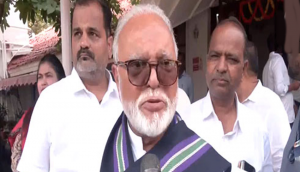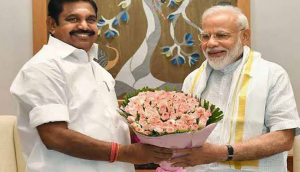Why the Congress' dismal scenario in Gujarat does not come as a surprise

The Congress in Gujarat has been brought down to its knees. The ongoing drama has been marked by the departure of Shankersinh Vaghela, the party's most popular leader in the state, and was followed by a spate of resignations of six members of the Legislative Assembly.
Also, there was the compulsion to herd the remaining legislators to a resort in Karnataka to somehow ensure the victory of Congress president Sonia Gandhi's political secretary Ahmed Patel in the Rajya Sabha polls.
But all should not come as a surprise. It is something that was bound to happen, given the way this party has functioned in the most politically important state of the country over the last two decades.
The general view is that the party leaders have brought this political crisis upon themselves and are reaping today what they have sown in terms of collective political inefficiency.
Come to think of it, the political observers are unable to even recollect that who was the last effective Gujarat Pradesh Congress Committee (GPCC) president. It has been almost 33 years since when the Congress came to power as a strong political entity under Madhavsinh Solanki in 1985, winning 149 seats out of 182 – something that the Narendra Modi-Amit Shah duo plan to outdo in this nursery of Hindutva politics this year.
After Solanki, whenever the Congress managed to come to power, it was in an alliance and through the back door.
No lessons learned?
The talk in Gujarat these days is about how the Congress never learnt from history. It justifies the quote – “Those who forget the past are condemned to repeat it”.
Using the strategy of herding away MLAs to a location outside the state was first introduced in Gujarat by none other than Vaghela when he had rebelled against the BJP regime led by Keshubhai Patel in 1995.
He had then taken 47 MLAs to Khajuraho only to return and get Suresh Mehta anointed as the new chief minister. From then onwards the terms Khajurias (those who went to Khajuraho symbolising rebels) and Hajurias (those who stayed back symbolising loyalists) has dominated the political discourse in Gujarat.
Today it is the same Vaghela who has compelled the Congress leadership to adopt his strategy as he stands at the nerve centre of the drama while sitting in the no man's land on the political turf of Gujarat.
Observers point out that the Congress high command never showed any urgency or sharp decision-making skills while dealing with debacle after the debacle in Gujarat. Instead of trying to study and analyse the successive poll defeats and then come out with remedies, all that has been happening is resignations by the GPCC presidents and their replacements.
There have been occasions when the party high command took months to decide whether to accept or not to accept these resignations thus giving a message to the party workers that Gujarat never was a priority for the high command.
A coterie of leaders
Another thing which has peeved the Congress rank and file in the state is that over the last two decades the post of GPCC president and that of the leader of opposition has just been shuffling between a select few and the most prominent of these have been Shankersinh Vaghela, Arjun Modhwadia, Shaktisinh Gohil and Bharatsinh Solanki.
This has left the other leaders, particularly among the younger ones, with very little motivation.
“The question is that when was the last time that an effort was made to bring up a new and young leadership in the state? The last such attempt was during Indira Gandhi's time when she brought in leaders like Madhavsinh Solanki, Naresh Raval, Prabodh Raval, Amarsinh Chaudhary and Ahmed Patel while also giving prominent space to those like Jinabhai Darji. Such a process has not been seen in the last two decades,” points out veteran political analyst RK Mishra.
He goes on to point out that there was some hope when Congress vice president Rahul Gandhi started the initiative to revamp the Congress through a pilot project on Youth Congress some years ago, but that was abandoned in the middle. Sources suggest that this exercise was actually scuttled by the old timers in the party.
A large number of people continue to hold the view that despite being an RSS import Vaghela was the best bet for the Congress but Ahmed Patel ensured that he was never given a free hand while being the state unit chief.
Vaghela understands the RSS mindset and strategies very well and has the ability to take on Modi and give a befitting reply to the latter in his own language. This has been demonstrated many times by him right from the time when he split the BJP to launch his Rashtriya Janta Party (RJP).
In fact, a large part of the Congress workers, particularly those among the Muslims and Dalits besides others, have not been enthused with Ahmed Patel but are too scared to put forth their point of view given the all powerful position that he enjoys.
In the all important post-2002 period, Patel was hardly visible in the state Congress headquarters. A lot of people hold him responsible for the Congress not coming out strongly in Gujarat against the anti-Muslim carnage and subsequent developments like the spate of 'fake' encounters that were carried out.
Not taking the risk of losing the Hindu vote, the Congress approach on these issues in the state was always guarded.
What next?
With Vaghela's departure, the line of thought that the Congress would grow under Bharatsinh Solanki ahead of the state Assembly polls has its own flaws.
The first flaw is that Bharatsinh does not match the credibility and confidence of the masses that his father Madhavsinh enjoyed. People are questioning that if he is that powerful a leader why couldn't he stop MLAs like Thasra Ramsinh Rarmar and Balasinor Mansinh Chauhan from resigning? These were leaders from his own political karambhoomi of Kheda and Anand districts.
Similarly, the Congress workers are very disturbed over the departure of Viramgam MLA Tejashree Patel who was among the best performing Congress MLAs in the Gujarat Assembly. Sources say that more than Vaghela's posturing, it was the chances of Bharatsinh not giving her a ticket to re-contest that led to her shift to the BJP.
“What a coincidence that during the father's (Madhavsinh's) days the party saw a victory with 149 seats and during the son's (Bharatsinh's) tenure the party stands to face a wipeout,” pointed a media person based in Gandhinagar.
Over the last two decades, the party simply failed to capitalise on the positive response that it got amid fits and jerks. The Congress had done very well in 2004 Lok Sabha polls, just two years after the 2002 Assembly polls that saw the BJP sweeping the state under Modi, by winning 12 of the 26 seats.
The result in 2009 was also not bad as it won 11 of the 26 seats. The Dandi March organised in 2005 under former Mumbai MP Sunil Dutt that concluded with a massive gathering at a rally addressed by Congress leaders Dr Manmohan Singh and Sonia Gandhi helped the party hijack BJP's nationalist agenda for some time.
Similarly, Rahul's efforts at revival through the Youth Congress and the Congress' student wing NSUI in 2008-09 had also yielding positive results.
But all this was squandered at the altar of petty politics and one upmanship within the party.
Last year the party did well in the Gujarat local body polls and right now the disenchantment of Patels and Dalits along with the Muslims presents is another opportunity for the party to get things back on track. But it appears that the party is all set to falter again.
First published: 1 August 2017, 17:47 IST






![BJP's Kapil Mishra recreates Shankar Mahadevan’s ‘Breathless’ song to highlight Delhi pollution [WATCH] BJP's Kapil Mishra recreates Shankar Mahadevan’s ‘Breathless’ song to highlight Delhi pollution [WATCH]](https://images.catchnews.com/upload/2022/11/03/kapil-mishra_240884_300x172.png)

![Anupam Kher shares pictures of his toned body on 67th birthday [MUST SEE] Anupam Kher shares pictures of his toned body on 67th birthday [MUST SEE]](https://images.catchnews.com/upload/2022/03/07/Anupam_kher_231145_300x172.jpg)






